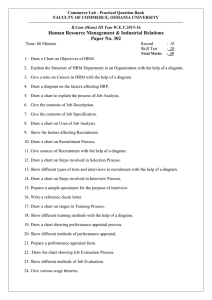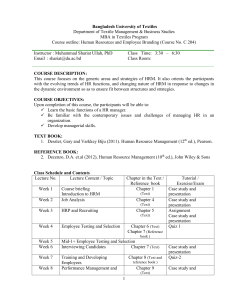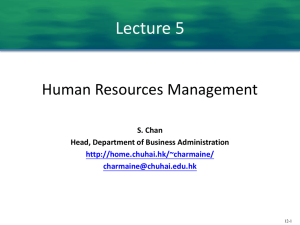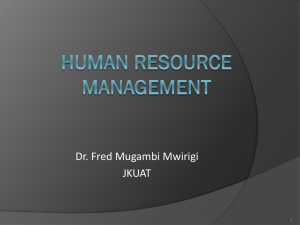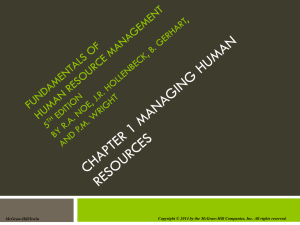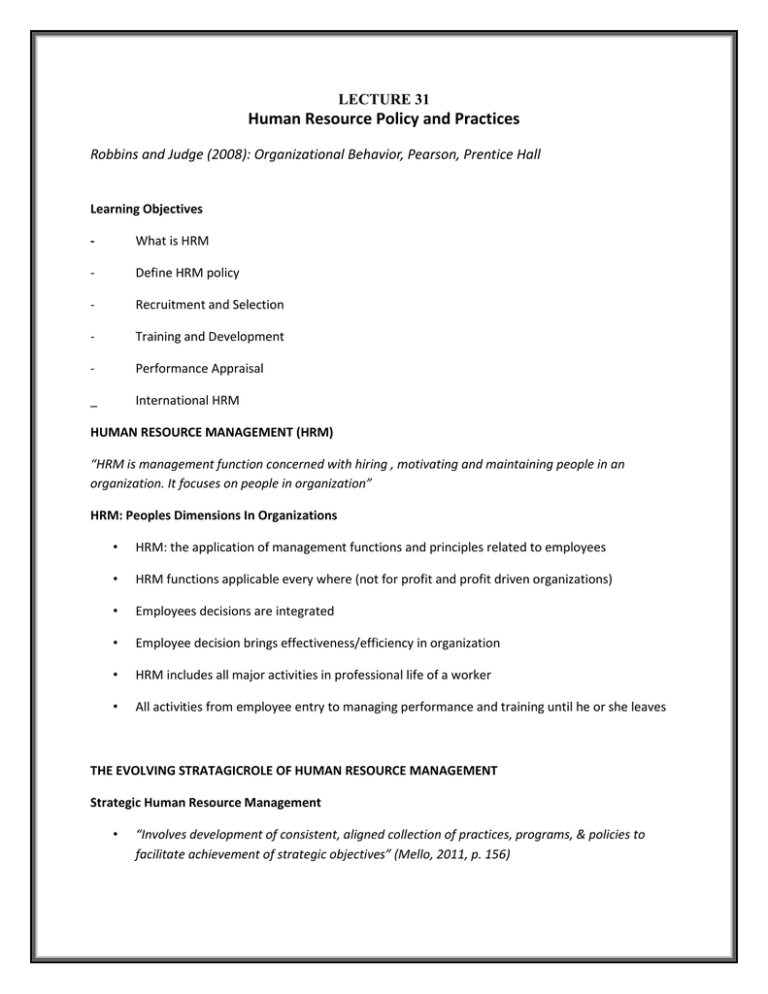
LECTURE 31
Human Resource Policy and Practices
Robbins and Judge (2008): Organizational Behavior, Pearson, Prentice Hall
Learning Objectives
-
What is HRM
-
Define HRM policy
-
Recruitment and Selection
-
Training and Development
-
Performance Appraisal
_
International HRM
HUMAN RESOURCE MANAGEMENT (HRM)
“HRM is management function concerned with hiring , motivating and maintaining people in an
organization. It focuses on people in organization”
HRM: Peoples Dimensions In Organizations
•
HRM: the application of management functions and principles related to employees
•
HRM functions applicable every where (not for profit and profit driven organizations)
•
Employees decisions are integrated
•
Employee decision brings effectiveness/efficiency in organization
•
HRM includes all major activities in professional life of a worker
•
All activities from employee entry to managing performance and training until he or she leaves
THE EVOLVING STRATAGICROLE OF HUMAN RESOURCE MANAGEMENT
Strategic Human Resource Management
•
“Involves development of consistent, aligned collection of practices, programs, & policies to
facilitate achievement of strategic objectives” (Mello, 2011, p. 156)
•
Mindset & practices away from “personnel management” & focusing on strategic issues instead
of operational issues
•
HR programs and policies are made and integrated in perspective of mission, objectives, and
strategy
•
Writing down HR strategy facilitates involvement & convincing senior executives & other
employees
HRM Activities
•
HR Planning
•
Job Analysis and Design
•
Recruitment and Selection
•
Training and Development
•
Remuneration
•
Welfare
•
Safe and Healthy Work Environment
•
Industrial relations
HR POLICIES AND PRACTICES
•
A policy is plan of action
•
HR policies need to ensure consistency and uniformity in treating people (guideline to course of
action)
•
It motivates employees and build loyalty
•
Benchmark to evaluate performance
HR POLICY DOCUMENT
Job Analysis
Job Analysis is the process of collecting data and information
analysis is job description and job specification
about a job and result of job
Recruitment
Recruitment is defined as “the process of searching for and obtaining applicant for jobs, from
among whom the right people can be selected” (p. 144)
-
Theoretically recruitment process ends when job applications have been received
In practice it goes further to screening applications to filter those applicants who are not
eligible for or suitable for job
The term recruitment is often described or understood as complete process of
employee hiring
-
Recruitment and selection are two different processes.
Source of Recruitment
Internal Recruitment
-
Former Employees (Performance is known, aware with organizational culture)
-
Previous Applicants (best when to fill in job quickly, cost effective)
2
External Recruitment
-
Advertisement: The most popular method
-
Blind ad (no identification of company)
-
AIDA (attention, interest, desire, action)
Content of Job Advertisement
I)
job content
ii)
working conditions
iii)
location of job
iv)
compensation
v)
job specification
vi)
to whom apply
Guidelines to Interviewers:
Nature of Training and Development
In general “training and development refers to the imparting of specific skills, abilities,
and knowledge to employee”
(p. 206)
In more detail “ training and development is any attempt to improve current or future
employee performance by increasing an employee's ability to perform through learning usually by
changing the employee's attitude or increasing his or her skills and knowledge. The need fro training and
development is determined by the employee's performance deficiency”
Training and development need = standard performance -Actual performance
-
Training is process of imparting skills and knowledge
-
Education is theoretical learning given in classroom
employees
Development activity aims to give learning opportunities that result in growth of
Training Process
Steps in Training Program
Performance Appraisal
•
Performance appraisal is to evaluate the performance of an employee to determine whether he
is performing his given task and duties well or to monitor whether he has given his best effort
and performance on given job
•
Performance appraisal is an assessment of individual performance, the performance is measured
against such factors as job knowledge, quality, quantity of output, initiative, leadership, abilities,
supervision, cooperation, judgment, analytical skills, problem solving skills, etc.
(P. 239)
•
The other similar terms often used for performance appraisal are performance rating, employee
performance review, employee assessment, personal appraisal, employee evaluation, or
performance evaluation
Performance Appraisal
Employee Benefits
International Human Resource Management
•
Globalization has significantly influence HRM practices and policies
•
All HRM functions need international orientation
•
MNC operating internationally need to be more focused to attract, motivate and
transfer workforce globally
•
The process of procuring, allocating, motivating, training & development, and
compensating and utilizing human resources in international business is called
international human resource management
•
IHRM covers six main functions of domestic HRM such as HR planning, recruiting,
training and development, performance management, compensation and labour
relations
•
The three countries categories of IHRM are country where headquarter is based,
country where subsidiary is located, and country from where workforce and finances
come
Managing International HR Activities
1) Cross Cultural Training:
2) Expatriate receives pre-departure training on host country culture to make it easy for
him/her to adjust to new culture
3) Expatriate often receives training on repatriation to avoid cross cultural shock
Managerial Implications
HR policies and practices are main force in shaping employee behavior and attitude
Recruitment and selection process determined who is hired and what is person-job level?
If there is flaw in selection process then more chances of job satisfaction, absenteeism, lower
productivity, low OCB and increase turn over
Training improves skills and increase potential to perform at higher level
Performance appraisal significance influence individual behavior
Performance and satisfaction increase when performance appraisal is fair more focus on
behaviors and result oriented criteria
Source: Robbins and Judge (2008): Organizational Behavior, Pearson, Prentice Hall

